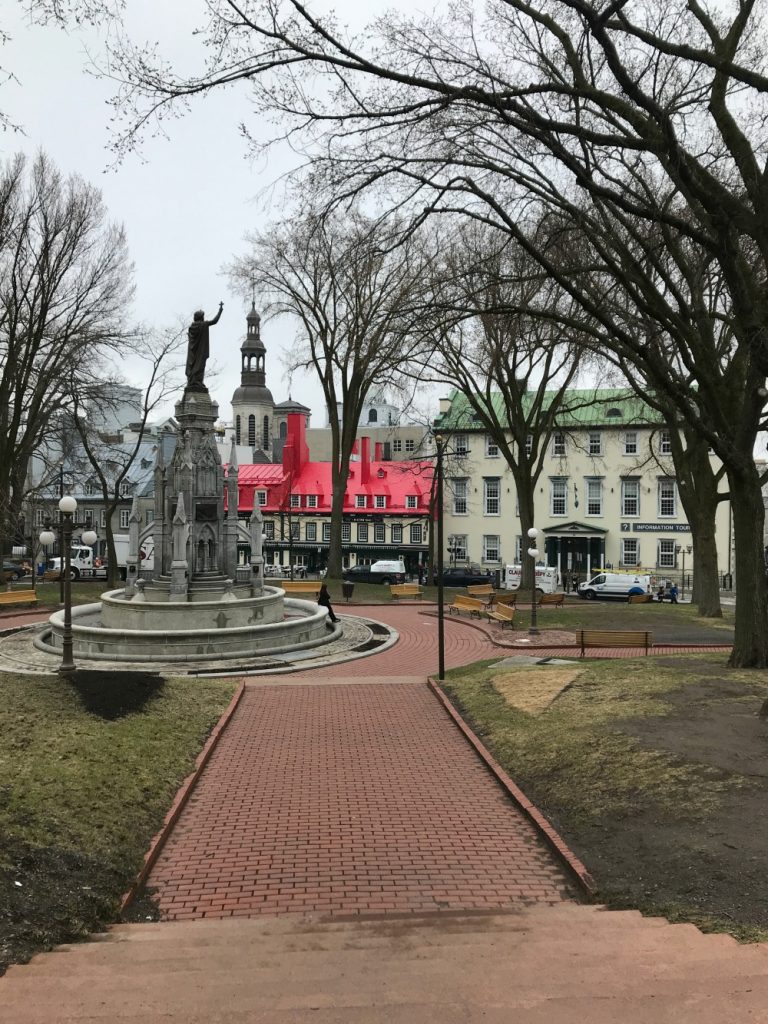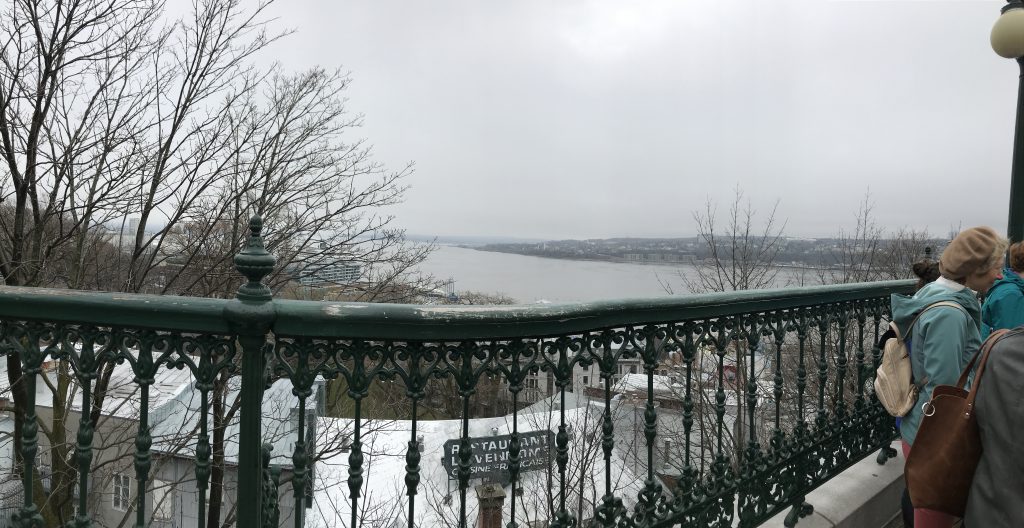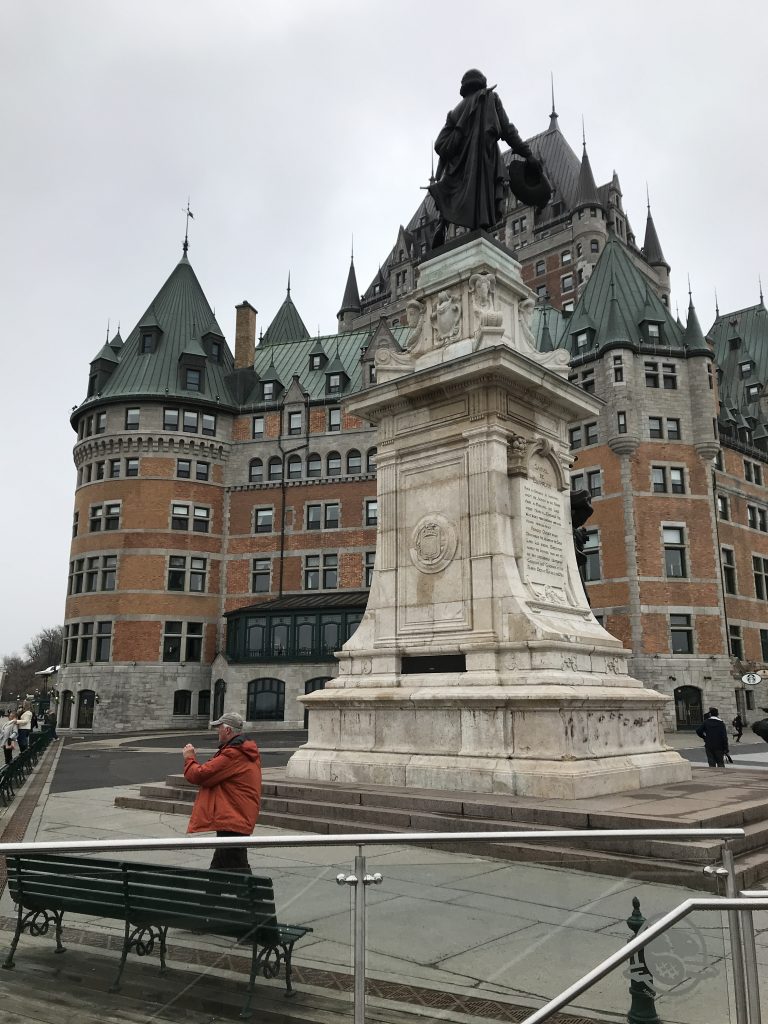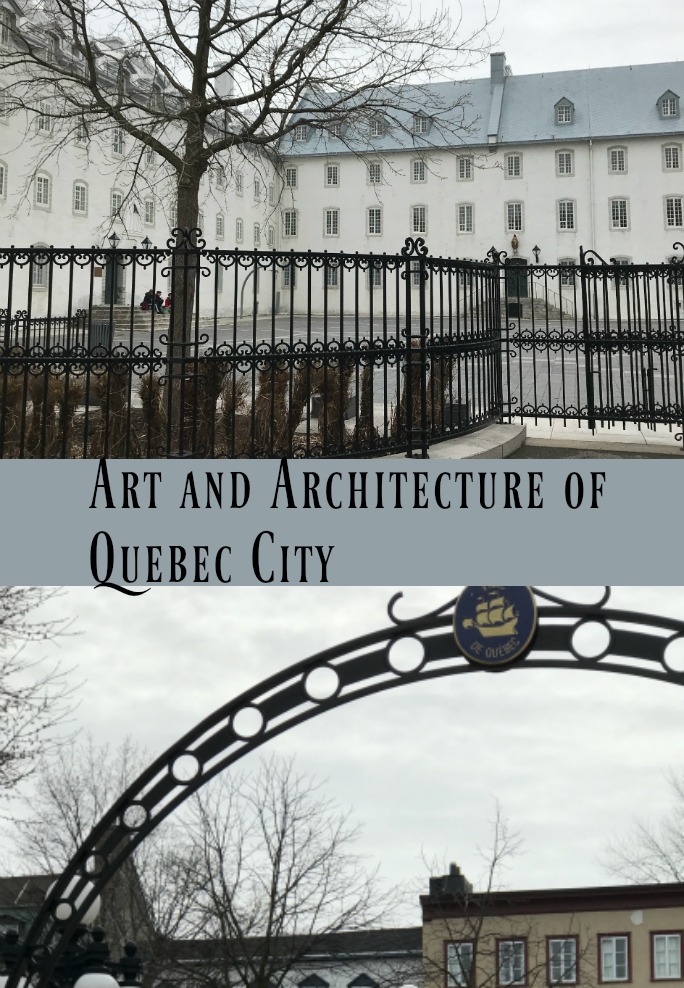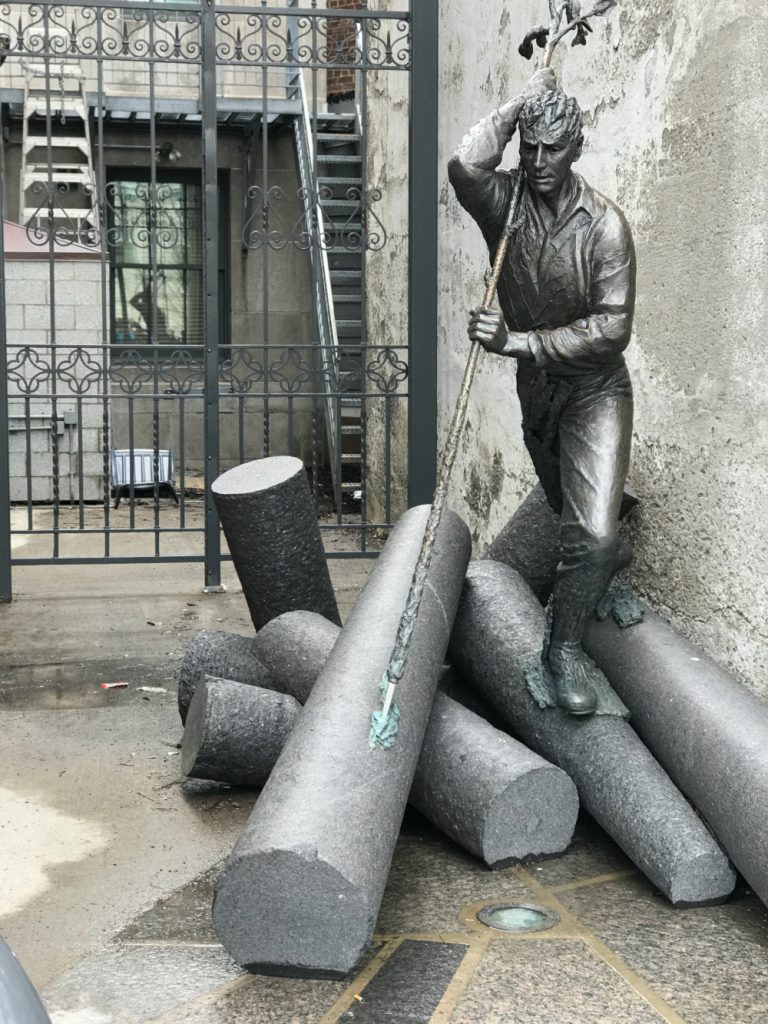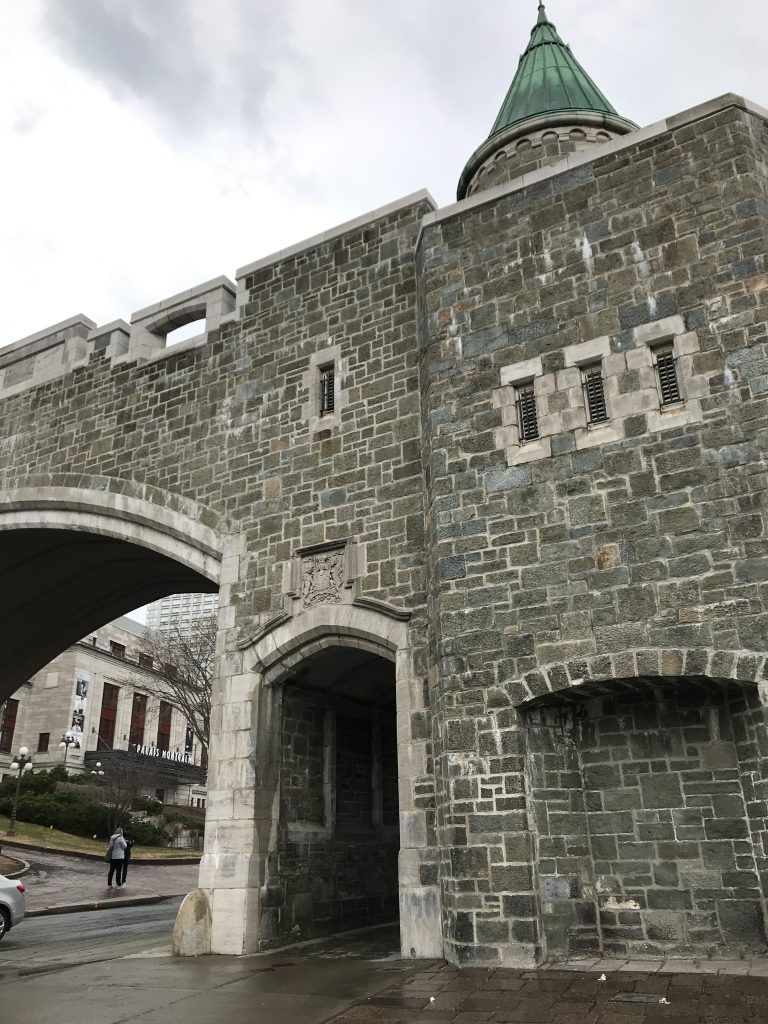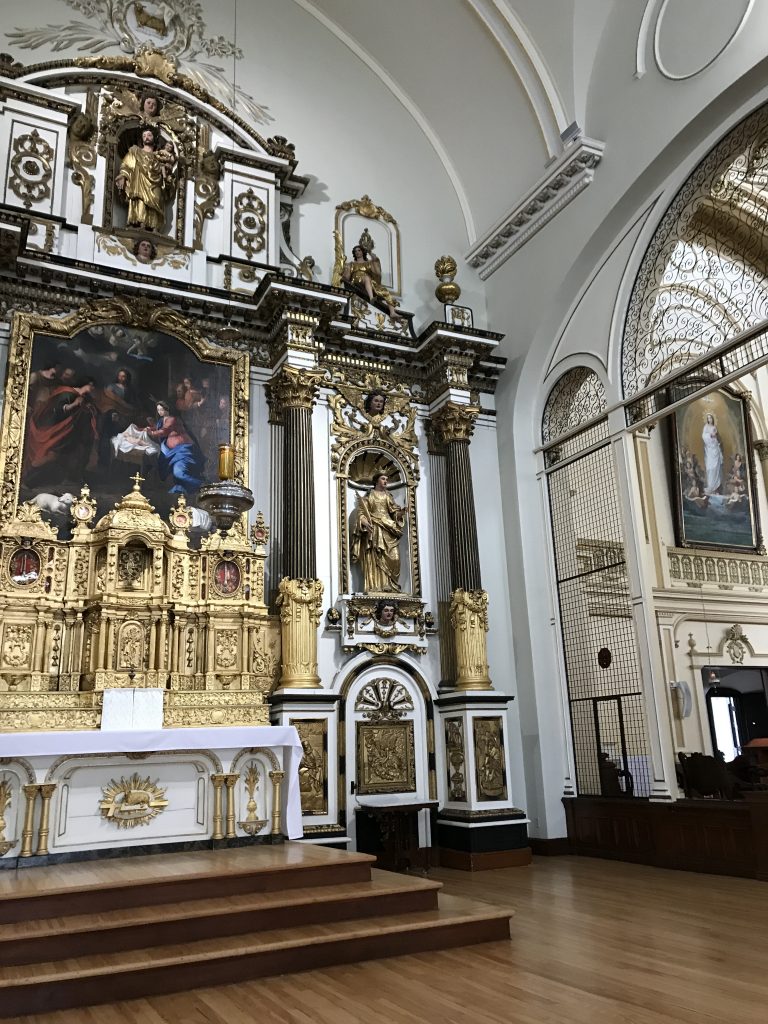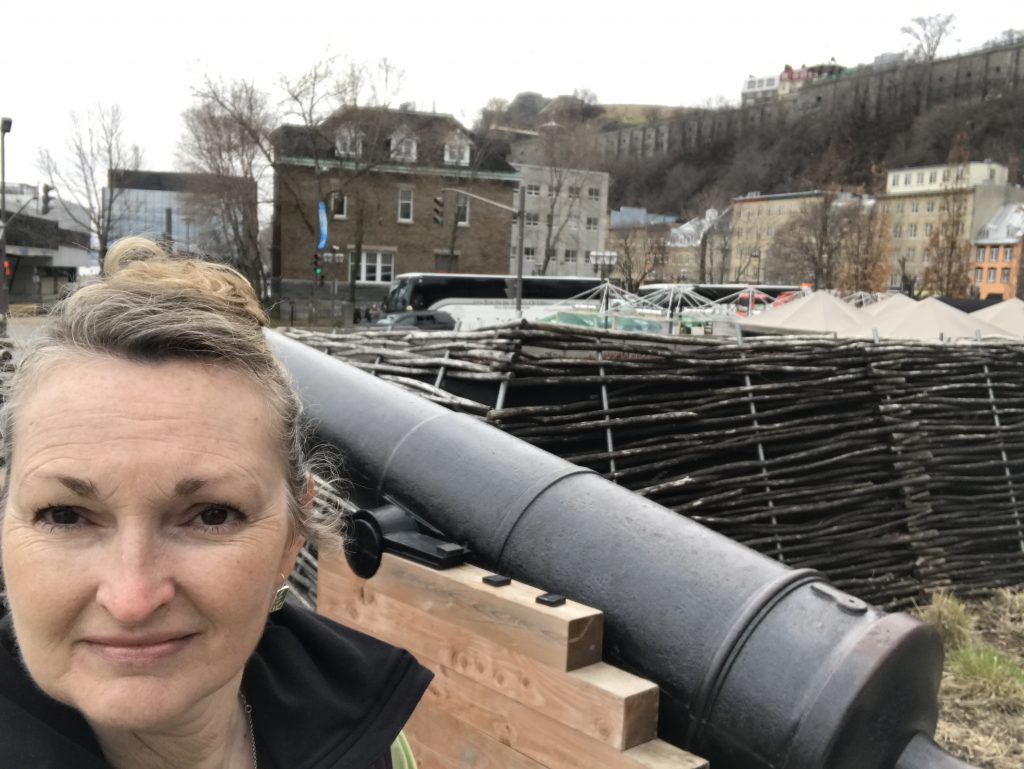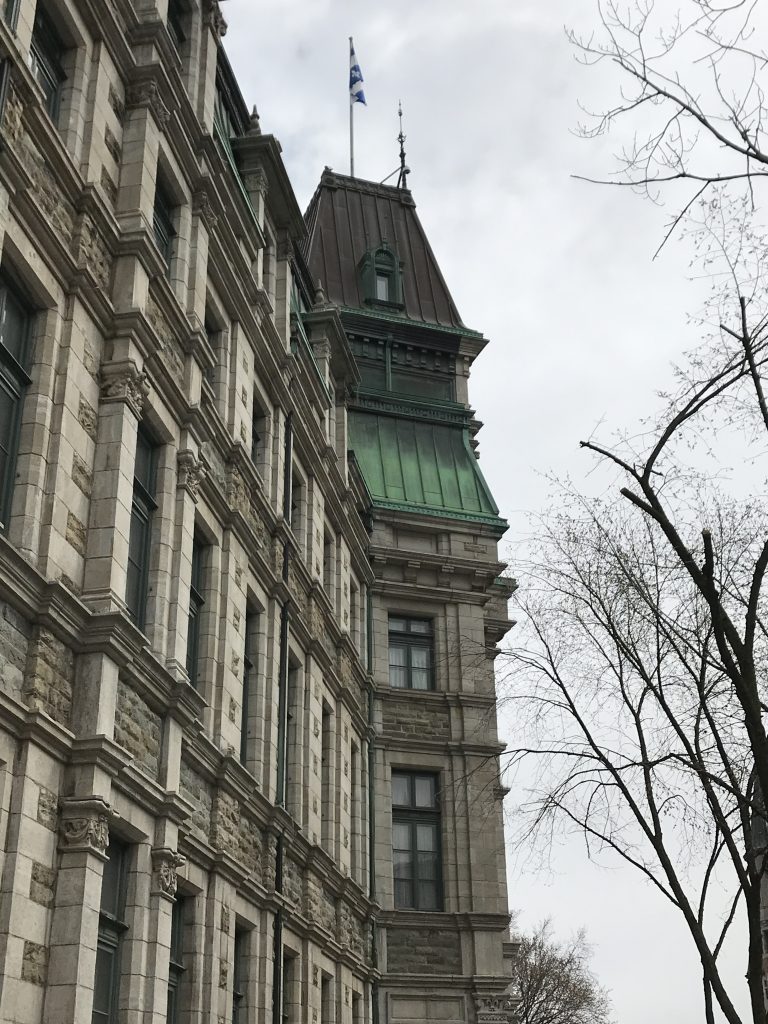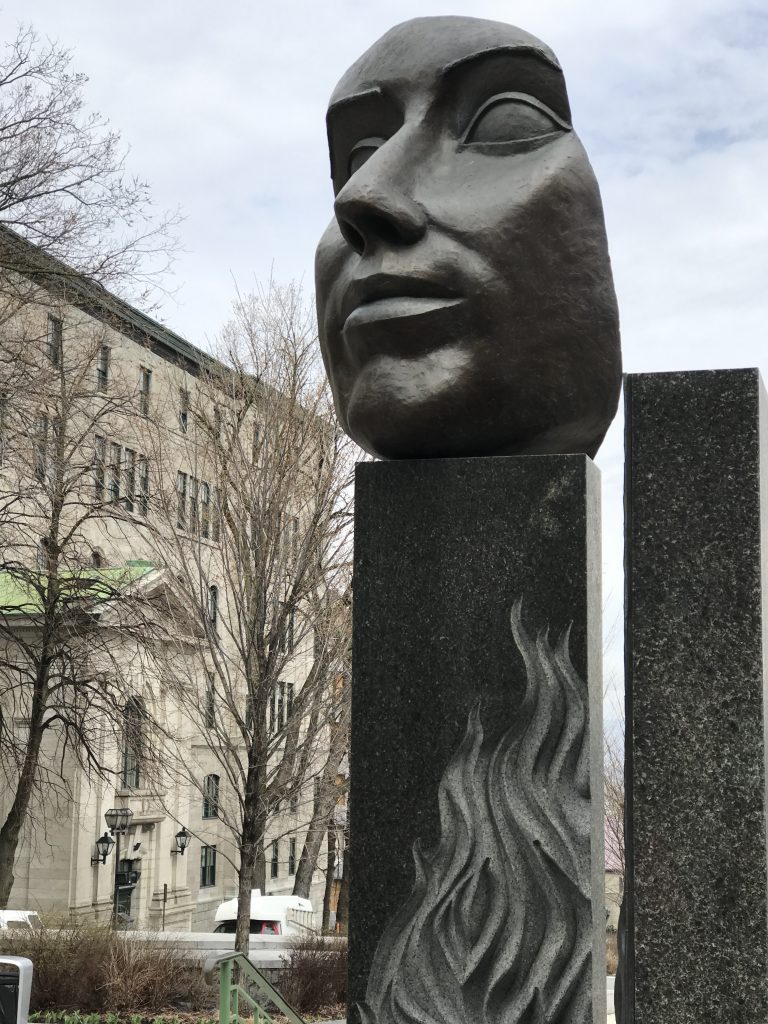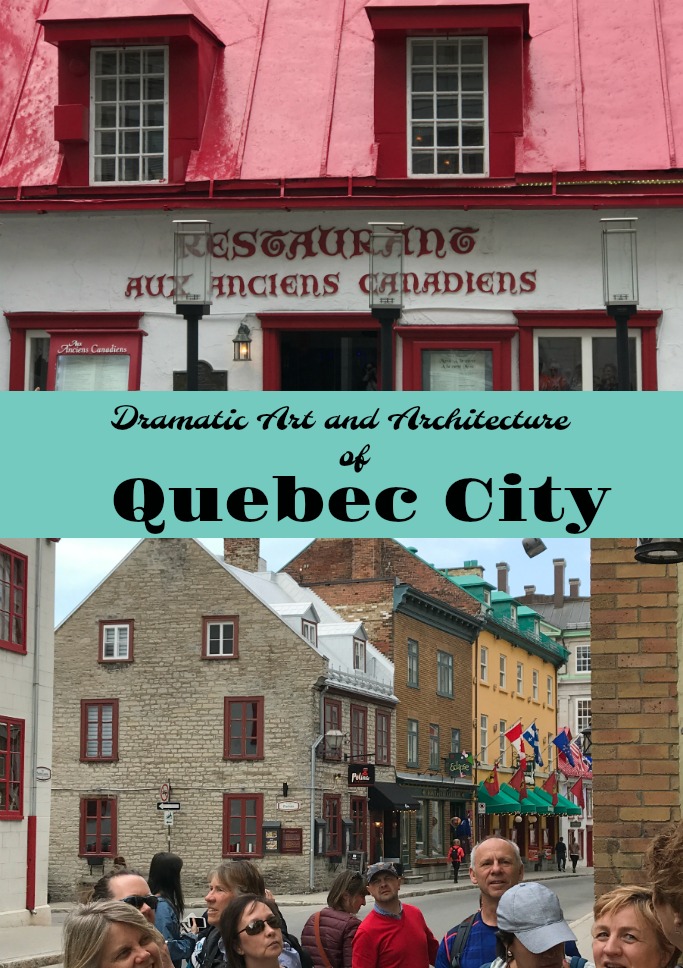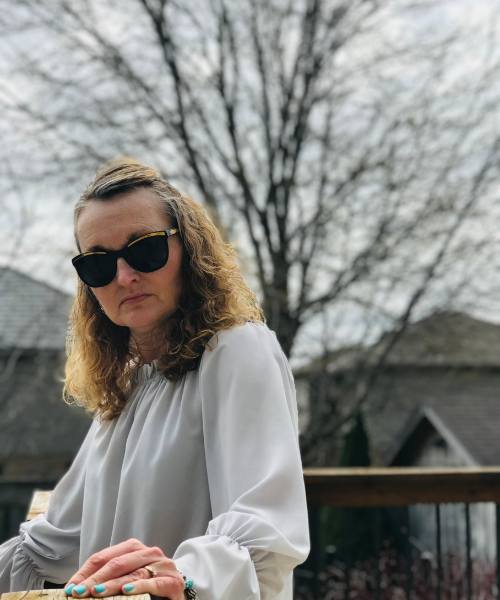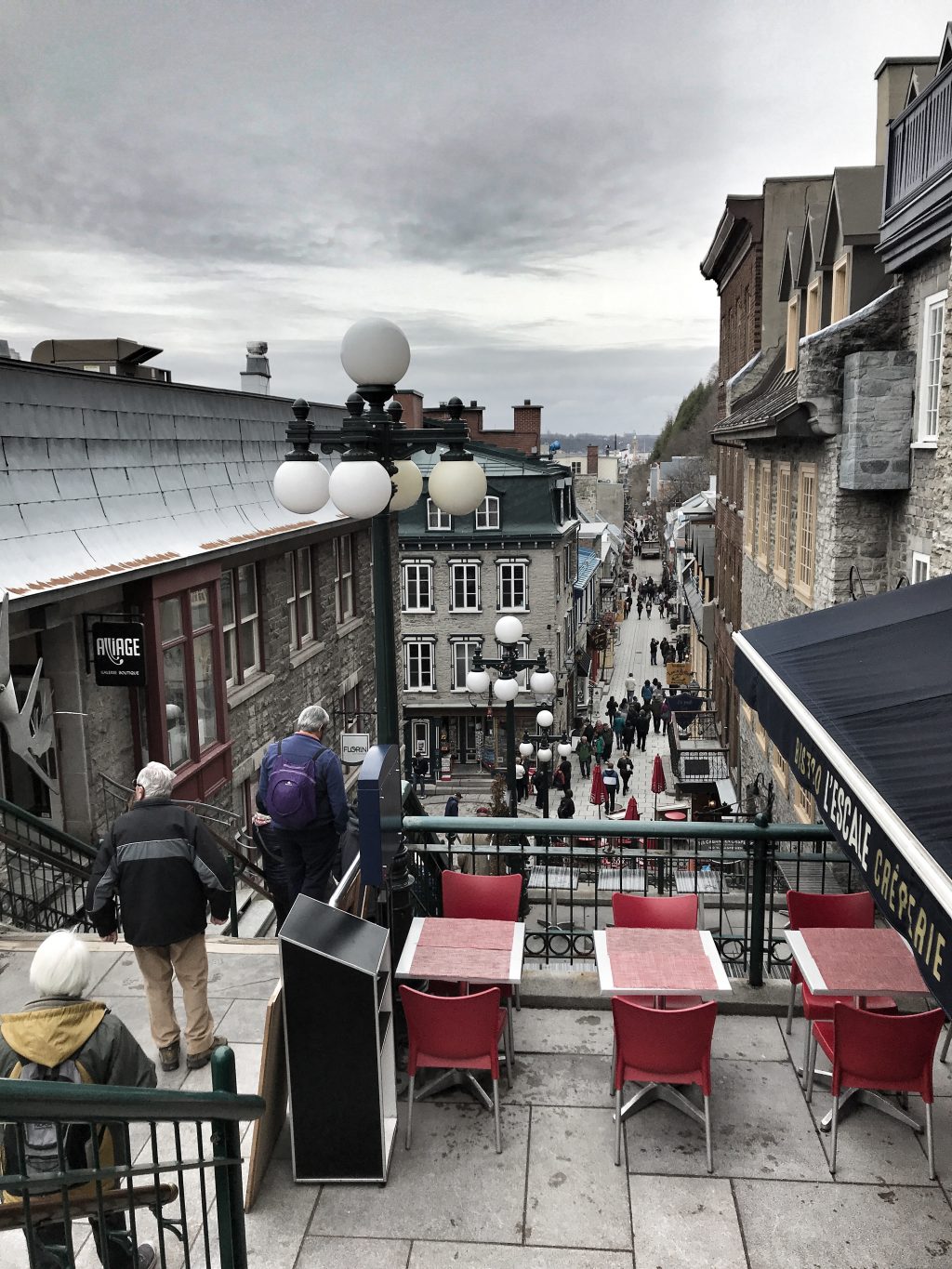
The Story of Quebec City Art and Architecture
Quebec City has a remarkable story written on its streets via the statues, public art and beautiful landmark buildings. The city is a slice of Europe and nowhere is that more apparent than in the magnificent Quebec City art and architecture punctuating the dramatic landscape. With strong Catholic influence, British and French flavour mingled with aboriginal traditions, this city is one of a kind.
Quebec City art and architecture tells a rich story of the city, how it started, the many challenges faced here, and of course how it evolved to be a popular heritage and cultural hub, as well as an international travel destination. Old Quebec City has been a Unesco Heritage site since 1985. It is distinctly an area that sprang from the St Lawrence River and is clearly still divided into old and new Quebec by the stunning wall that surrounds Old Quebec.
Recently I had the chance to visit the city for WITS 18 (Women in Travel Summit). We stayed at the Fairmont Chateau Frontenac for a couple of days prior to the start of the actual conference. Over the course of a chilly and rainy two days in May I took part in five incredible walking tours of the city. The Fairmont Chateau Frontenac proved to be the ideal base from which to explore everything this city has to offer.
One day after a truly enjoyable Quebec food tour we embarked on a Quebec City Art and Architecture walking tour with Tours Lévis Québec. Over the course of roughly 3 hours we covered many kilometres with our professional guide Judith. While I have been to the beautiful province of Quebec many times I had never visited Quebec City and this tour was an excellent way to gain insight into history and heritage there.
As a school child I remember well studying Quebec and Samuel de Champlain’s legacy. The walled city was interesting but the history lessons were lost on me then. Visiting the city in person as an adult to see how everything here has been shaped by Samuel de Champlain, along with French, British and aboriginal influences is a magnificent experience. Quebec City is a destination every Canadian should see to fully understand our history. It is as close to Europe as we get in Canada.
[tweetthis]Did you know Quebec City is the only fortified city north of Mexico? #travel #quebecoriginal #IFWTWA Read More…[/tweetthis]
From outside the Fairmont Le Chateau Frontenac, we learned of French influence and Louis the X1V’s plans to turn the city into a small Versailles. Quebec City is the only city in Canada developed as a French city. But there’s not much of that influence left. One single red brick in the foundation of the Chateau is all that’s left there that is truly French.
Departing from the Chateau Frontenac and heading straight to the Samuel de Champlain statue overlooking the St Lawrence river, this tour gives the foundations of history and it covers a lot of ground too. Old city, new city, lower city – you will visit them all in the Quebec City art and architecture tour.
Did you know Quebec City boasts over 40 museums and cultural centres? Four hundred public works of art adorn the city streets. Climate was the main issue here when settlers first arrived. Many went to the south. Others stopped in Quebec City, but geography and weather were huge factors inhibiting success.
Historically, the St. Lawrence River was vital to success and settlement. While The Great Lakes are pretty much positioned in middle of the continent and were vital to exploration in North America, the route there was up the St Lawrence. If you arrived in Quebec City in spring or summer and missed your boat out in September you were stuck. Ice forms quickly on the St. Lawrence and boats couldn’t leave after the ice formed. The first attempt at civilization was death by scurvy often.
Samuel de Champlain was first to work with the aboriginal population. That’s how colonization succeeded finally in Quebec City. Work with aboriginals was vital but nobody until Champlain understood that. He promised to protect them in exchange for them teaching him how to hunt and survive in the harsh new climate.
The Quebec harbour became a major trade spot. The layout of the city, that recently celebrated its 400th birthday, was established where the Samuel de Champlain statue is now.
In 1800s Quebec City decided it was important to maintain the footprint of the French. But much of the French influence had been dismantled but that time. The streets of Quebec City are very much a living breathing museum of all the factors that commingled to forge the city itself.
Church of course remains a major factor in Quebec City history and there are so many worth visiting here. The art, architecture and stained glass windows are memorable.
One of the beautiful things about travel to Quebec City is the fact that it is a human scale city designed so you can see the landscape from almost all vantage points. It is incredibly walkable and almost impossible to get lost. Follow the wall and you will return to the centre of the city. All the streets are parallel to the cliff wall.
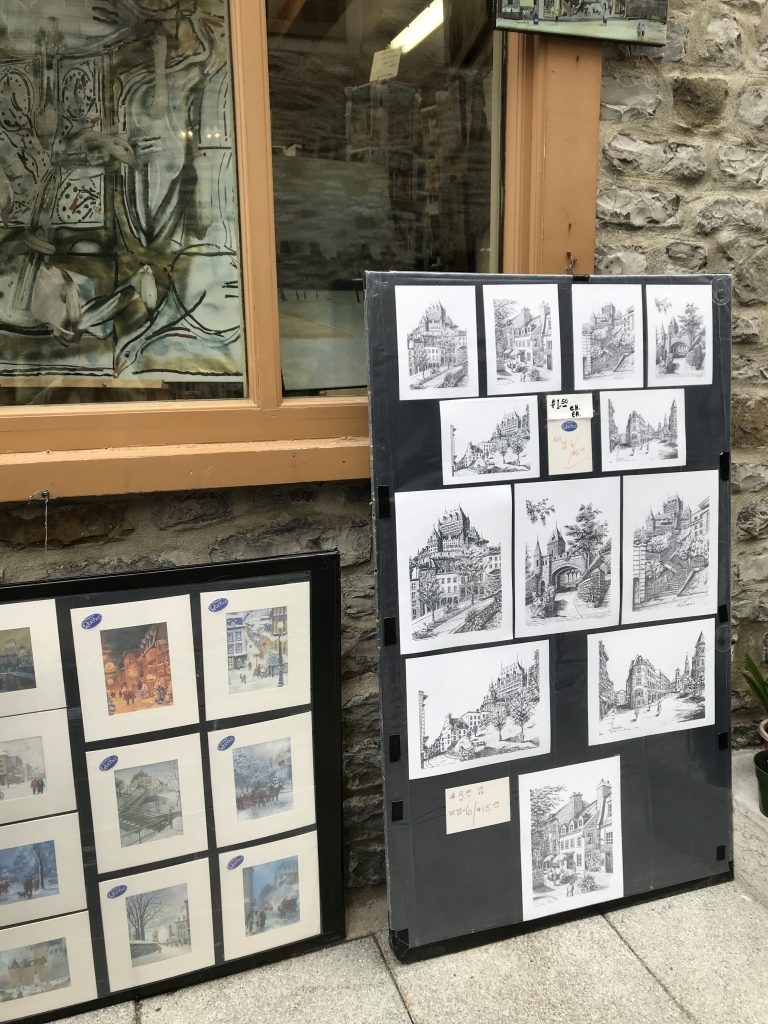
Find your way to Rue de Tresor, street of treasures, Artist’s Alley, originally named because it was the street you would walk down to get to the treasury. Visit artist’s alley. I wish I’d had time to buy some pictures.
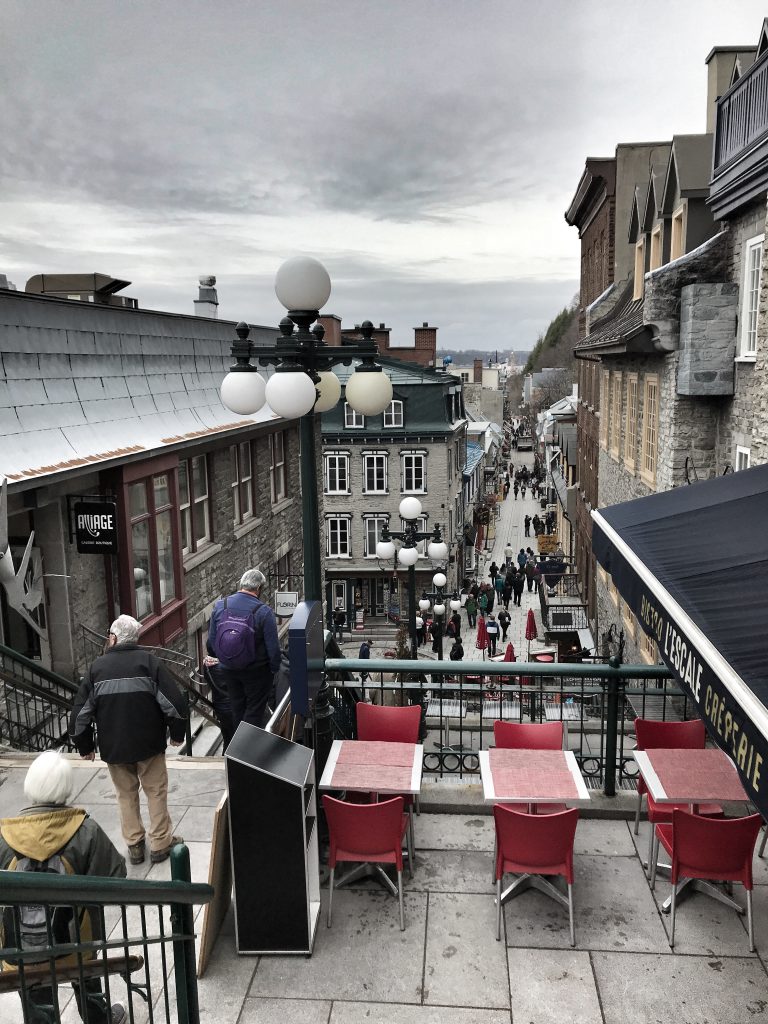
At some point most of Quebec buildings were white with walls of limestone. There are several examples of this nd one of the most noteworthy is Restaurants Aux Anciens Canadien, the oldest home in Quebec. This is a lovely restaurant we went to one night. It features several traditional dishes such as tortiere and French Onion soup.
Windows were often all lined up. Houses were built tight together so nobody could fit between houses and hide. So many remaining elements and features in this city will remind you it was a fortress. In the lower city cannons still exist and in fact you can see them throughout Quebec City, making great spots for photos.
The Chateau Frontenac is an example of Medieval style architecture. There are many influences on the streets surrounding the Frontenac. You will find copper rooftops on a few of the old buildings, especially the ones that had a government or public service function at one point.
You might think that the people here were shorter than average Canadians are these days, because the ceilings are so low in some buildings. But, in fact the low roof was intended to keep heat in.
The best place to be a woman in Canada is Quebec. Historically the city and province were very matriarchal. Nuns came here years ago as young women and they took a vital role in health and wellness of everyone. Here nuns were cloistered until the late 60s. Church up until 1968 controlled their life, school, religion.
Louis XIV wanted to be remembered as a king who promoted art and architecture. He was also one of the first to allow women to own property. In the early 1800s Quebec City women could vote in elections because they owned land. Some time after Louis, when leadership changed they declared only men with land could vote. Women’s right to vote was revoked and they did not get it again until the 1940s.
Near the monastery on the tour, there’s a beautiful monument with hand and quill that represents gift of education. Nuns were instrumental in education. When nuns were uncloistered in the late 1960s it was traumatic. Many women chose cloistered life at 15/16 then were suddenly released to live in society. The history of nuns and monasteries here is a compelling topic too. Seeking a health and wellness style weekend? Or a longer visit? Book Le Monastere Des Augustines, a renovated monastery you can stay in.
If you visit the city, be sure to do a tour or two. Book in advance because they are popular. On this Quebec City Art and Architecture walking tour you will be sure to see the School of Architecture, Seminaire de Quebec, a huge white building towards the end of the morning or afternoon. It is breathtaking and photographs extremely well so get your cameras ready. This tour ends in the charming lower city, which feels a lot like Paris.
Walk up the stairs or take the Funiculaire which is $3 and a fun ride. But first spend an hour or two in he lower city shopping at the one of a kind Quebec City shops and restaurants. We picked up insanely good salads at one of the small grocery shops.
Quebec City Art and Architecture Tour
Quebec City art and architecture tells the story of the city and parts of the province too. It is stunning and well worth exploring. This Quebec City art and architecture tour was educational and a great way to get a window into the history of the area. Tours Lévis Québec offers a History Walking Tour which sounds equally educational and informative.
What you need to know:
- WEAR good walking shoes. There is a lot of walking on this Quebec City art and architecture walking tour.
- Bring money for tips.
- Tours run all year round
- Bring some money if you wish to take the Funiculaire at end. (a fun lift back up to the Frontenac that is $3 (2018) per person) Tour ends in lower city.
- Camera of course, and water bottle as well. Dress accordingly. Umbrella if it is rainy, and gloves, plus winter coats if it is snowing.
- For more details about the Region and all there is to do and see check the Quebec City web site.
When you visit stay at the Fairmont Le Chateau. Book the Fairmont Quebec City stay here with TripAdvisor.
The post may contain affiliate links as a service to my readers. This is the Quebec Art tour we did. Ours was a small group tour provided for WITS attendees, but there are private tours too. It was exceptional. If you make a purchase via one of the links here, I receive a small commission at no extra cost to you.


